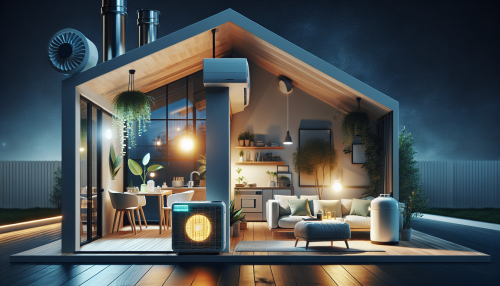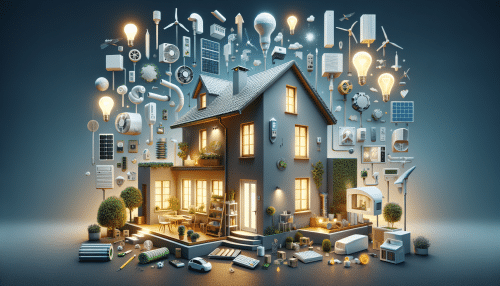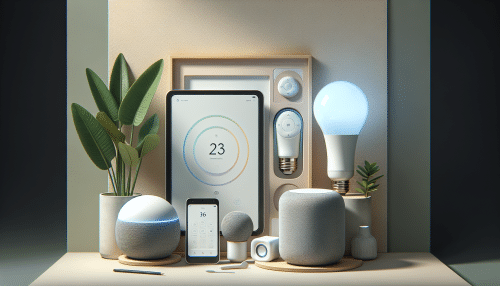Smart Home Devices You’ll Actually Use Every Day
Olivia Morgan November 12, 2025
Curious about smart home devices and how they can transform daily life? Explore the genuine advantages, essential features, and practical integration strategies that make smart home gadgets a worthwhile addition for comfort, safety, and energy savings. Learn which options fit households seeking a seamless living experience.
The Growing Appeal of Smart Home Technology
Smart home devices have captured the attention of households worldwide with their blend of convenience and innovation. These technologies—ranging from smart thermostats to voice-activated assistants—promise to simplify everyday routines and offer a level of control that previously felt futuristic. Today, people are drawn to the idea of automating mundane tasks, regulating home conditions remotely, or optimizing entertainment at the tap of a button. Whether you prefer tailored lighting, hands-free cleaning with robot vacuums, or integrated home security, the available options are varied and increasingly accessible. Demand for these gadgets isn’t just about novelty; many seek greater energy efficiency, safety, and comfort at home, often discovering unexpected uses once devices are installed.
The initial appeal of smart home technology often begins with awareness—seeing a friend dim the lights with a smartphone or checking a live doorbell camera from work. These small demonstrations of convenience add up. What may start as a single device, like a smart plug, can mature into an interconnected home ecosystem. Voice-controlled speakers become home hubs, tying together sensors, cameras, and climate controls to enhance daily living. For many, the appeal is also in the flexibility—most systems can be scaled and upgraded, allowing for a gradual approach to home automation. This adaptability means households can customize solutions to fit their lifestyles and budgets without committing to a whole-house overhaul from day one.
Safety, savings, and peace of mind are additional drivers behind the rise in smart home device adoption. Monitoring security systems remotely, receiving alerts for smoke or water leaks, and tracking energy or water usage are practical ways these devices deliver value. Even rental properties are benefiting, as plug-and-play solutions can travel from one home to another. Smart technology is evolving beyond luxury to become an everyday home essential, and as accessibility grows, even more households are discovering its practical side. This trend is supported by organizations focusing on energy conservation and security improvements, which increasingly reference the role of these devices in shaping the homes of tomorrow.https://www.energy.gov/eere/buildings/articles/role-smart-home-technologies-energy-efficiency
How Smart Home Devices Elevate Daily Living
Smart home devices are designed to seamlessly improve comfort, efficiency, and functionality in daily routines. By automating common household tasks, these gadgets minimize effort and allow users to focus on more meaningful activities. For instance, smart thermostats learn household patterns, adapting temperatures automatically based on occupancy and personal preference. Lighting systems can be programmed to mimic sunrise, fostering natural wake-up routines. Even simple upgrades, like smart plugs or bulbs, offer control through voice assistants or mobile apps, giving occupants a sense of mastery over their surroundings. The integration of these devices not only supports busy lifestyles but can also encourage new habits, such as increased energy-consciousness, leading to reduced utility bills over time.
Another transformative feature is enhanced household security. Smart security cameras stream real-time footage to smartphones, enabling people to check on kids, deliveries, or property conditions in seconds. Video doorbells let users converse with visitors safely, whether home or away. Many security systems send push notifications for unexpected activity, helping ensure prompt responses to situations like open doors or movement when the home is supposed to be empty. Some systems integrate with local emergency dispatch for extra responsiveness. These real-time capabilities offer assurance, especially for households focused on privacy and peace of mind.https://www.safewise.com/resources/smart-home-statistics/
Wellness and accessibility are also enhanced through smart home features. Automated blinds help regulate indoor temperatures and block harmful UV rays, improving comfort without constant manual adjustments. Voice-controlled assistants assist those with mobility challenges, granting autonomy over lighting, music, or communication. Smart kitchen devices even help streamline meal planning and grocery management, with fridges that alert to expiring food and ovens that preheat remotely. Collectively, these tools don’t just offer comfort—they create a living environment responsive to individuals’ changing needs and preferences, making homes inclusive and adaptive.
Popular Smart Devices and Their Practical Uses
Certain categories of smart home devices consistently rank as favorites due to their reliability, convenience, and real-world utility. Smart speakers like Amazon Echo or Google Nest Hub act as home command centers, letting users play music, answer queries, set reminders, or manage other smart products. Smart displays add visual elements for video calls or recipe browsing. Smart lighting stands out for both ambiance and practicality—it can simulate occupancy for security or shift automatically for comfort and mood. These lighting solutions often pay back over time through energy savings facilitated by schedules and sensors.
Security devices remain another fast-growing segment. Video-enabled doorbells, motion sensors, and whole-home alarm systems are pivotal for those wanting an extra layer of defense. Door and window sensors keep tabs on entry points, while remotely monitored cameras offer visibility from virtually anywhere. Most of these solutions are designed for easy installation, and many are compatible across platforms thanks to standardized protocols like Zigbee or Z-Wave. This interoperability ensures more households can integrate multiple devices without needing professional rewiring or proprietary hubs.
Smart thermostats are a standout for those interested in sustainability and savings. These adaptive devices learn patterns to minimize energy use, adjusting heating and cooling schedules based on weather forecasts and occupancy sensors. Over time, this not only saves money but reduces the home’s environmental footprint, appealing to the eco-conscious. Some models even participate in grid demand response programs, further promoting energy efficiency at scale.https://www.energystar.gov/products/smart_thermostats
Troubleshooting Integration and Compatibility Challenges
While smart technology brings a host of benefits, users sometimes face integration or compatibility challenges. Not all devices “speak” the same language, so people often encounter issues connecting products across brands. Most new devices support popular protocols, but older equipment or lesser-known brands may lack interoperability. Compatibility charts and customer reviews can be valuable resources prior to purchase, helping ensure devices will connect seamlessly with existing networks or platforms. In some cases, a central smart hub may be needed to bridge devices, making integration more reliable as systems grow.
Another issue is connectivity. Smart devices rely on stable Wi-Fi connections, particularly those that stream or transmit data (like cameras or displays). Interference, signal range, or internet outages can disrupt performance. Mesh networks or Wi-Fi repeaters can address coverage gaps in larger homes, while most devices offer offline modes to maintain minimal functionality even if the internet drops. Manufacturers often provide troubleshooting guides and customer support to help with these issues, and user forums offer peer-based solutions. Consumers can also proactively secure networks, protecting devices from unauthorized access.https://consumer.ftc.gov/articles/how-secure-your-home-wi-fi-network
Privacy concerns also come to the forefront with any internet-connected device. People are increasingly aware of data privacy—not just from cyberattacks, but from over-collection of personal habits or routines. Before purchasing, it’s recommended to review privacy settings, manufacturer data use policies, and update devices with the latest security patches. Some households set up isolated guest networks for smart devices or use additional encryption to minimize risks. With informed choices and ongoing management, the benefits of these technologies can be realized safely and securely.
Tips for Selecting and Setting Up Smart Devices
Choosing the right smart home device begins with assessing household priorities. For comfort, look at lighting and climate controls; for security, focus on monitoring devices and sensors. Compatibility is key, so consider products that support open standards or integrate with popular platforms like Alexa, Google Assistant, or Apple HomeKit. Reading independent reviews and consumer safety ratings can highlight both strengths and limitations, helping set realistic expectations.
Set-up usually starts with downloading a manufacturer’s app and connecting each device to the home Wi-Fi network. Most products include guided instructions, but those less comfortable with tech may find video tutorials helpful. Some retailers or service providers offer professional installation, while major manufacturers support robust online FAQs and live help chats. Think about device placement to maximize effectiveness—position cameras for wide views, sensors at key entry points, and thermostats away from heat sources for accurate readings.
Personalization is where smart home technology shines. Automate lighting schedules in sync with sunrise and sunset. Link door sensors to voice assistants for real-time updates. Combine different devices into “scenes”—like Movie Night, which dims lights and powers up entertainment systems simultaneously. Experimenting with automations can reveal creative solutions to daily challenges while making the system uniquely yours. Maintenance involves occasional firmware updates and battery checks, ensuring continued smooth operation and peace of mind.https://www.techhive.com/article/3399202/how-to-set-up-your-smart-home.html
The Future of Smart Homes: Trends to Watch
The smart home ecosystem continues to evolve quickly, with new technologies on the horizon promising even broader capabilities. Artificial intelligence is reshaping how devices “learn” from user habits, adjusting more proactively to routines. Energy management is another frontier, as more devices offer granular usage insights and communicate directly with utility providers to optimize energy loads and reduce waste. Integration with renewable energy sources is also growing, enabling solar-powered solutions, real-time consumption tracking, and even smart appliances that adapt cycles to periods of low grid demand.
Voice control and gesture-based interfaces are being refined for better accessibility, while hardware advances enable devices to shrink in size but expand in functionality. Robots for cleaning or caregiving are becoming more sophisticated, and refrigerators may soon help plan meals or automatically replenish groceries. Some cities are designing entire communities with interconnected systems, moving beyond single-household setups to neighborhood-scale smart management. These developments highlight how today’s investments in home technology can lay the groundwork for futureproof living environments.https://www.cnet.com/home/smart-home/future-of-smart-homes/
Concerns about equity, safety, and data protection will shape ongoing innovation. As more devices become mainstream, it’s possible that prices will fall while features increase. Accessibility for renters and older adults is already accelerating, with more portable or user-friendly equipment emerging. Staying curious and informed will help every household—and individual—find the smart home path that delivers the most comfort, security, and ease. The journey is just beginning, and the possibilities continue to expand every year.
References
1. U.S. Department of Energy. (n.d.). The Role of Smart Home Technologies in Energy Efficiency. Retrieved from https://www.energy.gov/eere/buildings/articles/role-smart-home-technologies-energy-efficiency
2. SafeWise. (n.d.). Smart Home Statistics and Trends. Retrieved from https://www.safewise.com/resources/smart-home-statistics/
3. ENERGY STAR. (n.d.). Smart Thermostats. Retrieved from https://www.energystar.gov/products/smart_thermostats
4. Federal Trade Commission. (n.d.). How to Secure Your Home Wi-Fi Network. Retrieved from https://consumer.ftc.gov/articles/how-secure-your-home-wi-fi-network
5. TechHive. (n.d.). How to Set Up Your Smart Home. Retrieved from https://www.techhive.com/article/3399202/how-to-set-up-your-smart-home.html
6. CNET. (n.d.). The Future of Smart Homes. Retrieved from https://www.cnet.com/home/smart-home/future-of-smart-homes/





